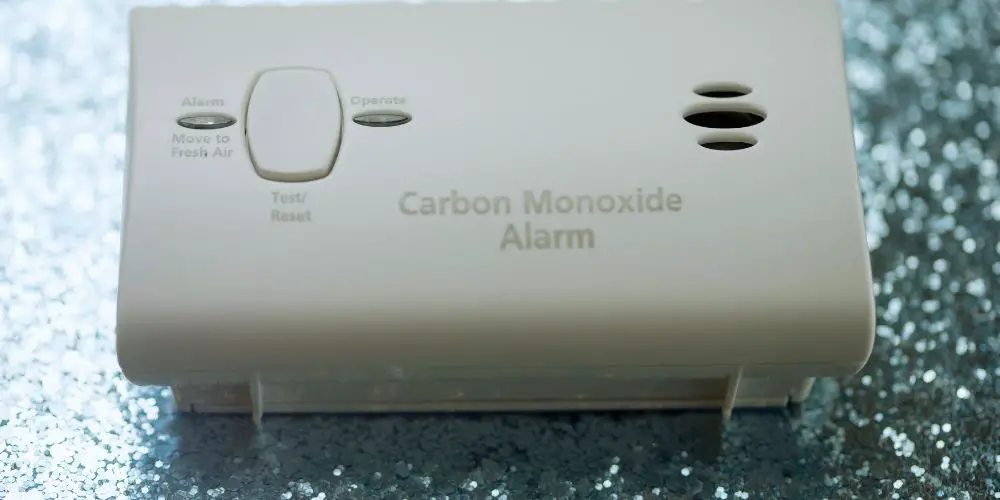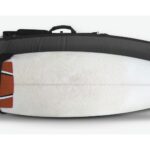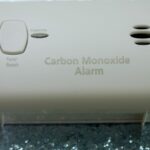Traveling can be a great way to explore new places, experience different cultures, and create lasting memories. However, it’s important to understand how to safely travel with a carbon monoxide detector when on the road. One potential hazard that travelers should be aware of is carbon monoxide poisoning.
Carbon monoxide is a colorless, odorless gas that can be deadly if inhaled in high concentrations. It’s produced by fuel-burning appliances such as gas stoves, furnaces, and water heaters and can build up in enclosed spaces like hotel rooms, vacation rentals, and even cars.
Bringing a carbon monoxide detector with you is essential to protect yourself and your loved ones from carbon monoxide poisoning while traveling.
A carbon monoxide detector is a device that measures the concentration of carbon monoxide in the air and sounds an alarm if levels become dangerous.
With a carbon monoxide detector, you can have peace of mind knowing that you’ll be alerted if there’s a carbon monoxide leak in your accommodation or vehicle.
Key Takeaways:
- Carbon monoxide is a colorless, odorless gas that can be deadly if inhaled in high concentrations.
- Bringing a carbon monoxide detector with you while traveling can help protect you from carbon monoxide poisoning.
- Choosing the right carbon monoxide detector for your travel needs is as important as knowing how to use it properly.
Table of Contents
Understanding Carbon Monoxide and Its Dangers
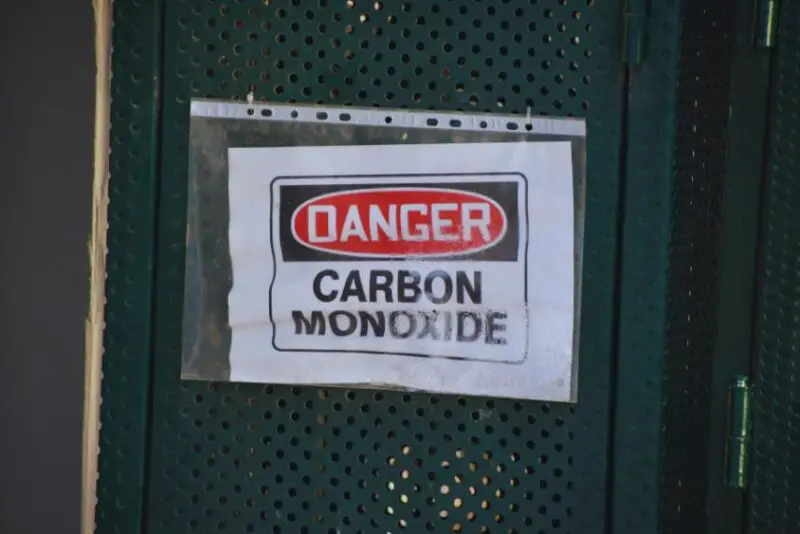
Carbon monoxide (CO) is a colorless, odorless, and poisonous gas that the incomplete burning of fuels such as wood, charcoal, gasoline, propane, and natural gas can produce. It is a serious health hazard that can cause illness, brain damage, and even death.
Carbon monoxide poisoning occurs when CO gas builds up in the bloodstream, replacing oxygen and preventing it from reaching vital organs such as the heart and brain. The symptoms of carbon monoxide poisoning can be similar to those of other illnesses, such as the flu, making it difficult to diagnose.
Some common symptoms of carbon monoxide poisoning include headaches, dizziness, nausea, vomiting, confusion, chest pain, and weakness. In severe cases, it can cause loss of consciousness, coma, and death. The risk of developing symptoms increases as the level of CO in the air increases.
It is important to note that everyone is at risk of carbon monoxide poisoning, but some people are more susceptible than others. Infants, the elderly, and those with heart or lung disease are at higher risk of developing symptoms of carbon monoxide poisoning.
To protect yourself and your loved ones from the dangers of carbon monoxide, it is important to have a working carbon monoxide detector in your home and when traveling.
A portable carbon monoxide detector can alert you to CO gas in your hotel room or rental unit, allowing you to protect yourself and your family immediately.
Carbon monoxide is a poisonous gas that can cause serious health problems and even death. Understanding the symptoms of carbon monoxide poisoning and protecting yourself and your family from this dangerous gas at home and when traveling is important.
The Importance of a Carbon Monoxide Detector
When traveling, it is important to prioritize your safety and the safety of those around you. A carbon monoxide detector is an essential device that can help ensure your safety.
Carbon monoxide is a colorless, odorless gas that can be lethal if inhaled in high concentrations. A working carbon monoxide detector can alert you and your travel companions to the presence of this gas, giving you time to evacuate the area and seek medical attention if necessary.
First Alert, a leading manufacturer of carbon monoxide detectors, recommends packing a portable carbon monoxide detector when traveling.
These detectors are easy to transport and can be used in various settings, including hotel rooms, Airbnb rentals, and campsites. Some models even come equipped with a built-in alarm to alert you to dangerous levels of carbon monoxide.
It is important to note that not all carbon monoxide detectors are created equal. When purchasing a carbon monoxide detector, look for one tested and certified by a reputable organization, such as Underwriters Laboratories (UL).
Additionally, make sure to test your carbon monoxide detector regularly to ensure that it is working properly. First Alert recommends testing your detector once a month and replacing the batteries at least once a year.
In summary, a carbon monoxide detector is essential for safety while traveling. Packaging a portable carbon monoxide detector and testing it regularly can help protect yourself and your travel companions from the dangers of carbon monoxide poisoning.
Choosing the Right Carbon Monoxide Detector for Travel
When choosing the right carbon monoxide detector for travel, there are a few key factors to consider. Here are some important things to keep in mind:
Portability
Portability is one of the most important factors when choosing a carbon monoxide detector for travel.
You’ll want to choose a small and lightweight detector to pack in your luggage without wasting too much space or adding too much weight. Look for a portable carbon monoxide detector that is specifically designed for travel.
Battery-Operated
Another important factor to consider is whether the carbon monoxide detector is battery-operated. This is important because you can only sometimes access an electrical outlet when traveling. Look for a detector that uses standard batteries that are easy to replace, such as AA or AAA batteries.
Digital Display
A digital display can be a useful feature to look for in a carbon monoxide detector for travel. This will allow you to see the current carbon monoxide levels in the room easily so you can take action if necessary. Some detectors also include an audible alarm to alert you if the levels become dangerous.
Recommended Product
One highly recommended travel carbon monoxide detector is the First Alert CO710 Carbon Monoxide Detector, available on Amazon. This small and lightweight detector makes it easy to pack in your luggage.
It is also battery-operated and features a digital display to show current carbon monoxide levels. It has a loud alarm to alert you if levels become dangerous.
When choosing a carbon monoxide detector for travel, look for one that is portable, battery-operated, and has a digital display. The First Alert CO710 Carbon Monoxide Detector is an excellent option to consider.
- Keep your family safe with this easy to use digital-display, 10-year battery operated carbon monoxide alarm; Battery powered alarms provide continuous monitoring of CO levels, even if there’s a power failure
- Easy-to-read backlit digital display shows temperature and CO concentration; Peak Level feature displays the highest concentration of carbon monoxide measured
- Built-in 10-year lithium battery offers continuous protection for the life of the carbon monoxide detector
Last update on 2024-09-21 at 10:58 / Affiliate links / Images from Amazon Product Advertising API
How to Use a Carbon Monoxide Detector When Traveling
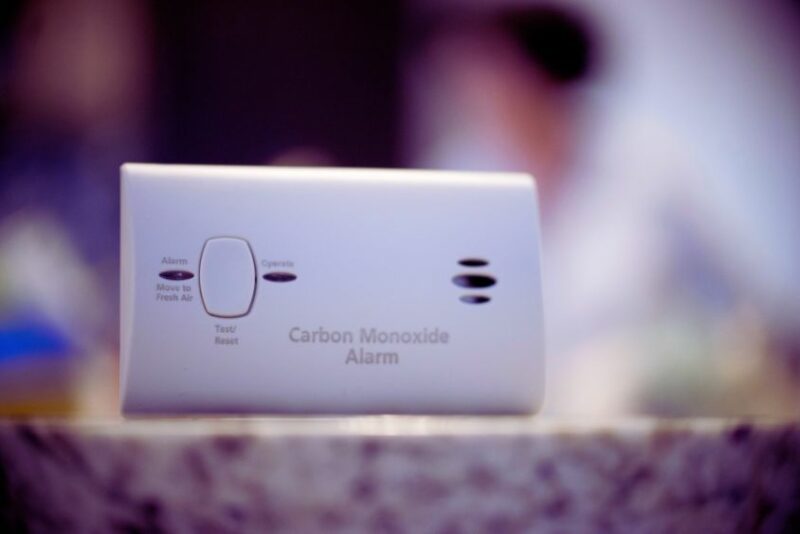
Traveling with a carbon monoxide (CO) detector is a smart way to help protect yourself and your loved ones from the dangers of carbon monoxide poisoning. Here are some tips on how to use a carbon monoxide detector when traveling:
1. Choose the Right Type of Detector
When choosing a CO detector for travel, look for a portable, battery-operated, or plug-in model that is easy to pack and use. Portable detectors are especially useful when traveling abroad, as they can be used in different accommodations.
Ensure the detector has a UL 2034 mark on its packaging, verifying it meets the safety standard for carbon monoxide alarms.
2. Place the Detector in the Right Location
Place the detector in a central location where you will sleep or spend the most time. Place the detector on a nightstand or dresser near the bed if you stay in a hotel room. If you stay in a vacation home or rental unit, place the detector in the main living area or the bedrooms.
3. Test the Detector
Before using the detector, test it to ensure it functions properly. Follow the manufacturer’s instructions for testing the detector, which typically involves pressing or holding down a test button.
If the detector does not sound an alarm during the test, replace the batteries or contact the manufacturer for assistance.
4. Know the Symptoms of Carbon Monoxide Poisoning
Even with a CO detector, knowing the symptoms of carbon monoxide poisoning is important. These include headache, dizziness, weakness, nausea, vomiting, chest pain, and confusion.
If you or someone else experiences these symptoms, move to fresh air immediately and seek medical attention.
5. Follow Safety Precautions
To further reduce the risk of carbon monoxide poisoning when traveling, follow these safety precautions:
- Never use fuel-burning devices like portable gas stoves or charcoal grills inside a hotel or vacation home.
- Ensure all fuel-burning appliances, such as gas stoves and water heaters, are properly vented and maintained.
- Do not run your car engine or generator in enclosed spaces like a garage or tent.
- If you need clarification about the safety of a particular accommodation, ask the hotel or rental property owner if they have a CO detector installed.
These tips can help ensure a safe and healthy travel experience for you and your loved ones.
Safety Measures to Prevent Carbon Monoxide Poisoning
When traveling, taking precautions to prevent carbon monoxide poisoning is important. Here are some safety measures you can take:
- Install a Carbon Monoxide Detector: Pack a portable battery-operated or battery backup carbon monoxide detector in your luggage. This will help you detect any dangerous levels of carbon monoxide in your hotel room, Airbnb, or camping site.
- Service Heating Systems and Appliances: Have your heating system, water heater, and any other gas, oil, or coal-burning appliances serviced by a qualified technician every year. This will ensure that they are functioning properly and not emitting dangerous levels of carbon monoxide.
- Ventilate Enclosed Spaces: Never leave a motor running in a vehicle parked in an enclosed or partially enclosed space, such as a garage. Additionally, never run a motor vehicle, generator, pressure washer, or gasoline-powered engine less than 20 feet from an open window, door, or vent where exhaust can vent into an enclosed area.
- Use Charcoal Grills Outdoors: When using a charcoal grill, only use it outdoors in a well-ventilated area. Never use a charcoal grill indoors or in an enclosed space, as this can lead to dangerous levels of carbon monoxide.
- Avoid Fossil Fuels Indoors: Avoid using fossil fuel-burning appliances indoors, such as gas stoves or ovens, as these can also emit dangerous levels of carbon monoxide. If you need to use these appliances, open a window or door to ventilate the area.
Following these safety measures can help prevent carbon monoxide poisoning while traveling. Always prioritize your safety and take the necessary precautions to protect yourself and your loved ones.
How To Travel With Carbon Monoxide Detectors in Different Accommodations
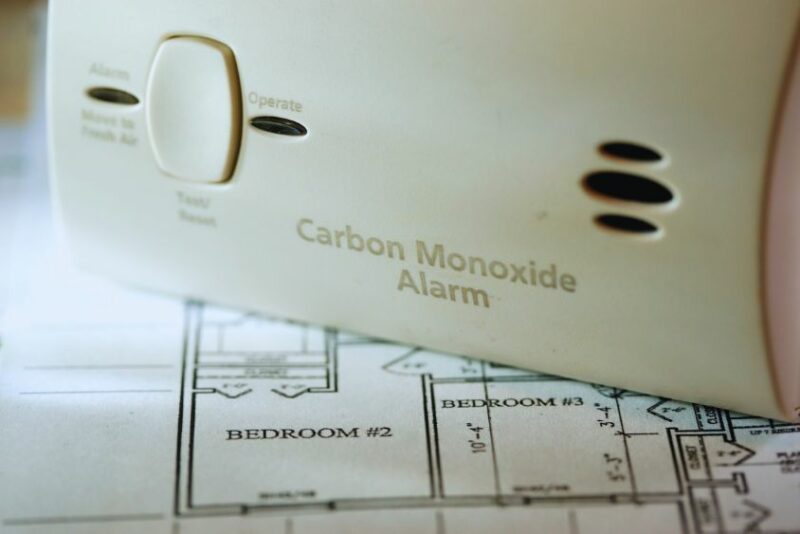
You must ensure safety by bringing a portable carbon monoxide detector when traveling. Different accommodations have different risks, and knowing how to use your detector correctly in each situation is important.
Hotels
Hotels usually have carbon monoxide detectors installed, but it’s always better to be safe than sorry. Please bring your portable detector and place it on a nightstand or table near the bed when staying in a hotel. Make sure to keep it away from any windows or doors.
If traveling with a group, consider bringing multiple detectors and placing them in different rooms. If you notice any alarms going off, evacuate the room immediately and notify the hotel staff.
Airbnb and Vacation Rentals
Airbnb and vacation rentals may not have carbon monoxide detectors installed, so bringing your own is crucial. Place your detector in a central location, such as the living room or kitchen, where it can detect any potential leaks.
Before booking an Airbnb or vacation rental, ask the host if they have a carbon monoxide detector installed. Suppose they don’t consider finding a different accommodation.
Motels
Motels are similar to hotels because they usually have installed carbon monoxide detectors. However, it’s always better to bring your detector and place it in a central location in the room.
If you notice any alarms going off, evacuate the room immediately and notify the motel staff.
Camping
When camping, bringing a portable carbon monoxide detector with you is essential. Carbon monoxide can be produced by camping stoves, generators, and heaters, so it’s crucial to be aware of the risks.
Place your detector in a central location in your tent or RV, and keep it away from open flames. If you notice any alarms going off, turn off any potential sources of carbon monoxide and evacuate the area.
Overall, traveling with a carbon monoxide detector is a simple and effective way to ensure your safety while on the road. By following these tips, you can stay safe and enjoy your travels with peace of mind.
Traveling with Carbon Monoxide Detectors in Different Countries
Knowing the local laws and regulations regarding carbon monoxide detectors is important when traveling to different countries. While some countries may require them in certain accommodations, others may not have any regulations in place.
Here is what you need to know about traveling with a carbon monoxide detector in different countries:
United States
In the United States, carbon monoxide detectors are required in all residential buildings, including hotels and vacation rentals. You should bring your portable carbon monoxide detector when traveling to ensure your safety. You can purchase a portable carbon monoxide detector online or at your local hardware store.
See Carbon Monoxide Detector Regulations in the USA.
Mexico
Mexico has no specific laws or regulations regarding carbon monoxide detectors in accommodations. However, it is recommended that you bring your portable carbon monoxide detector when traveling to ensure your safety.
You can purchase a portable carbon monoxide detector online or at your local hardware store.
Bahamas
In accommodations, the Bahamas has no specific laws or regulations regarding carbon monoxide detectors. However, it is recommended that you bring your portable carbon monoxide detector when traveling to ensure your safety.
You can purchase a portable carbon monoxide detector online or at your local hardware store. No matter where you are traveling, it is important to be aware of the potential dangers of carbon monoxide poisoning and to take precautions to protect yourself and your loved ones.
Bringing your portable carbon monoxide detector is a simple and effective way to ensure your safety while traveling.
Final Thoughts on Traveling Safely with a Carbon Monoxide Detector
Traveling with a carbon monoxide detector is an important safety measure that can protect you and your loved ones from dangerous levels of this odorless gas. Here are some final thoughts on traveling safely with a carbon monoxide detector:
- Always pack a portable carbon monoxide detector in your travel bag. Look for one that is compact, easy to use, and has a long battery life. Check with your airline before traveling to ensure it is safe to bring your lithium battery-powered detector on board.
- When you arrive at your destination, test the detector to ensure it works properly. Follow the manufacturer’s instructions for testing and maintenance.
- If you are staying at a hotel or resort, ask the staff if they have carbon monoxide detectors installed in the rooms. If not, consider staying at a different location with this safety feature.
- Ensure the area is well-ventilated when using appliances that burn fuel, such as stoves or fireplaces. Do not use these appliances in enclosed spaces or near open windows or doors.
- If traveling to a foreign country, research the local laws and regulations regarding carbon monoxide detectors. Some countries may require them in certain types of buildings or accommodations.
- Remember that carbon monoxide can also be present near pools, hot tubs, and other water sources. Be aware of the risks and take appropriate precautions.
- Finally, be aware of the media reports and news stories about carbon monoxide poisoning. While rare, it can happen to anyone, including Americans traveling abroad. Stay informed and take the necessary steps to protect yourself and your family.
In conclusion, traveling with a carbon monoxide detector is an easy and effective way to stay safe while on the go. By following these simple tips, you can enjoy your vacation or business trip with peace of mind, knowing you are protected from this dangerous gas.
Frequently Asked Questions
Can I bring a carbon monoxide detector on an airplane?
Yes, you can bring a carbon monoxide detector on an airplane. According to the TSA, carbon monoxide detectors are allowed in carry-on and checked bags. It is important to note that the detector must be battery-operated and not hardwired into the building.
Where is the safest place to put a carbon monoxide detector?
The safest place to put a carbon monoxide detector is near sleeping areas. This ensures that you will be alerted if carbon monoxide leaks while sleeping. A detector on each level of your home and near any fuel-burning appliances is also recommended.
Should you bring your carbon monoxide detector?
It is highly recommended to bring your carbon monoxide detector when traveling. Many hotels and vacation rentals do not have carbon monoxide detectors installed, and it is better to be safe than sorry.
Portable carbon monoxide detectors are affordable and easy to pack in your luggage.
Will a carbon monoxide detector keep beeping if it detects carbon monoxide?
A carbon monoxide detector will keep beeping if it detects carbon monoxide. The beeping is a warning that there is a dangerous level of carbon monoxide, and you should evacuate the area immediately.
What is the best travel carbon monoxide detector?
The best travel carbon monoxide detector is portable, lightweight, and has a long battery life. The First Alert CO710 Carbon Monoxide Detector is a popular choice among travelers and lasts up to 10 years.
Is a portable smoke detector and carbon monoxide detector necessary for travel?
While it is unnecessary to bring both a portable smoke detector and a carbon monoxide detector when traveling, it is recommended.
Smoke detectors are important in a fire, while carbon monoxide detectors are important in a leak. Bringing both detectors ensures that you are prepared for any emergency.
